The right lighting can transform your outdoor space from merely functional to absolutely magical. As we move into 2025, the latest outdoor lighting trends combine cutting-edge technology with aesthetic brilliance to create spaces that are both inviting and innovative. Gone are the days when a single porch light was enough to illuminate your evenings outdoors. Today’s homeowners are seeking sophisticated, versatile lighting solutions that extend the usability of their outdoor spaces well into the night.
I’ve spent the last decade working with homeowners to create stunning outdoor environments, and lemme tell you, lighting technology has never been more exciting than it is right now. The newest options on the market aren’t just brighter or more efficient—they’re fundamentally reimagining how we experience our patios, decks, and gardens after sunset.
1. Hanging outdoor patio lights 2025 inspiration for backyards, covered decks, and modern designs
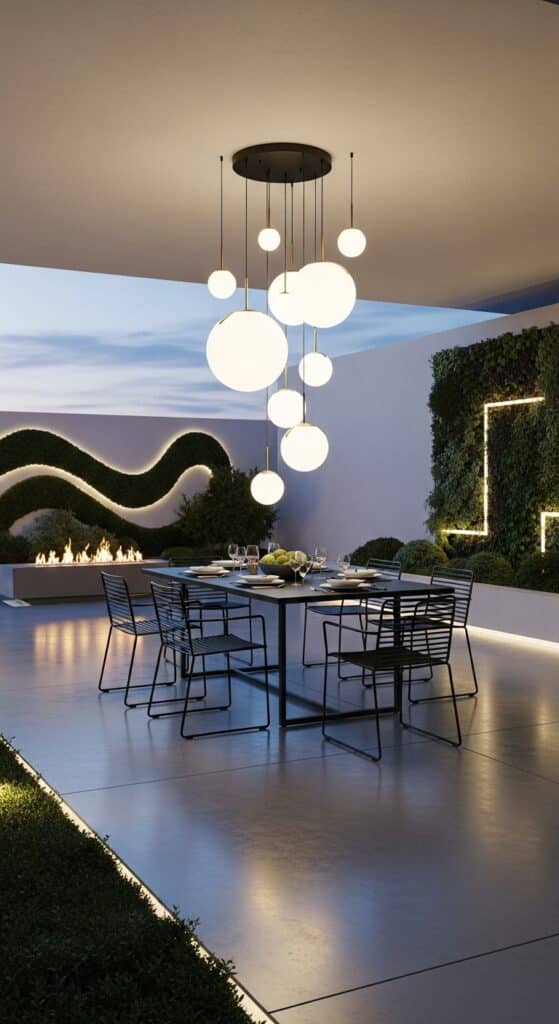
The hanging light trend has evolved dramatically for 2025. We’re seeing a fascinating shift toward sculptural pendants that create dramatic shadows and patterns on your outdoor surfaces. These aren’t your standard string lights anymore—think geometric metal forms with precision-cut patterns that cast intricate designs across your deck or patio.
For ultra-modern spaces, the new floating orb clusters are making a huge splash. These wireless, battery-powered spheres can be arranged in custom configurations and programed to slowly change color throughout the evening. Their soft, ambient glow creates an almost otherworldly atmosphere thats perfect for entertaning.
Many of the newest hanging fixtures incorporate weather-resistant materials that can withstand extreme conditions without compromising on style. Manufacturers have developed special polymers and treated metals that maintain their appearance despite years of exposure to sun, rain, and fluctuating temperatures. This durability factor is a game-changer for homeowners in variable climates who previously had to replace their outdoor fixtures every couple of seasons.
2. Outdoor patio lights 2025 hanging ideas for pergolas and covered decks on a budget
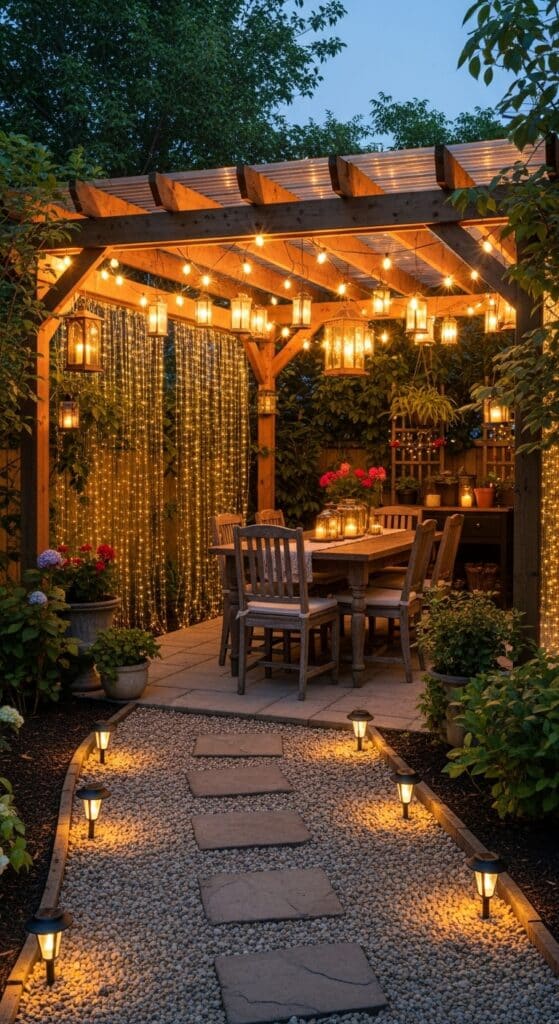
Not everyone has unlimited funds for outdoor lighting, but the good news is that 2025 has brought us incredible budget-friendly options. Modular string light systems allow you to start small and expand your lighting scheme as your budget permits. These systems feature interchangeable components that snap together without specialized tools or expertise.
Solar-powered fairy curtains are another affordable trend that’s taken off this year. These delicate vertical light strands create a waterfall effect when hung from pergola beams or deck overhangs. The best part? They charge during the day and automatically illuminate at dusk, costing literally nothing to operate after the initial purchase.
DIY lighting kits have also become more sophisticated while remaining accessible. Many now include smartphone connectivity right outta the box, letting you customize lighting patterns and intensities without investing in expensive smart home systems. I’ve seen amazing transformations using these budget-friendly kits that look like they cost thousands but actually come in under $100.
3. Light-Up Planters for Dual Purpose

One of my favorite innovations for 2025 is the integration of lighting into functional outdoor elements. Light-up planters represent the perfect marriage of greenery and illumination. These vessels house your favorite plants while providing a gentle glow that highlights your botanical specimens and provides ambient lighting for your outdoor space.
The newest models feature separate soil and lighting compartments to protect the electrical components from moisture. Many now include specialized growing lights that can be programmed to provide optimal conditions for different plant species—helping your greenery thrive even in shaded locations. The effect is both practical and stunning, creating islands of illuminated greenery throughout your outdoor space.
Self-watering versions take convenience to the next level, with integrated reservoirs and moisture sensors that maintain ideal growing conditions with minimal intervention. These smart planters can even send notifications to your phone when water levels are low or light bulbs need replacement. It’s like having a tiny garden assistant working 24/7 to keep your outdoor plants happy and your space beautifully lit.
4. String Lights to Enhance Covered Decks
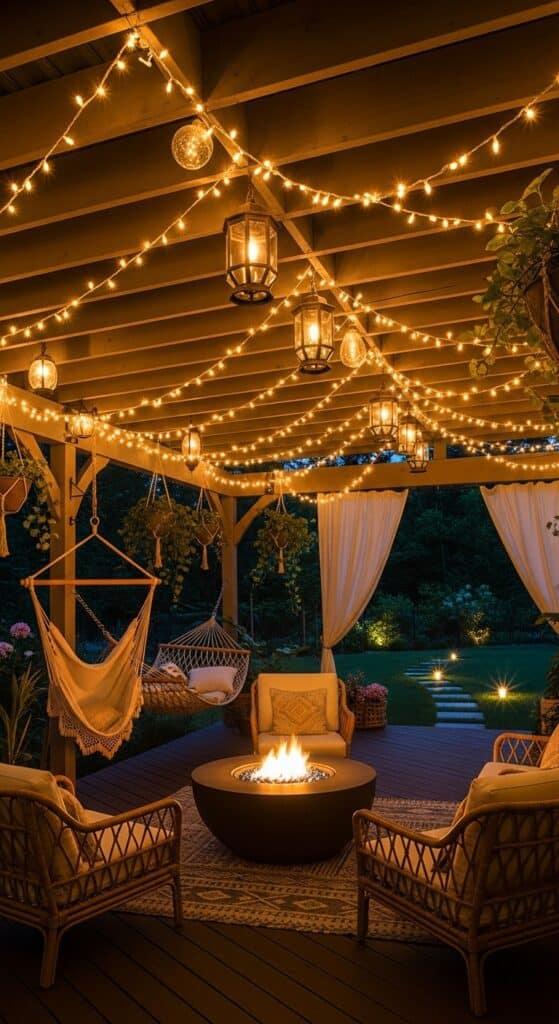
String lights continue to reign supreme for covered outdoor areas, but the 2025 versions offer unprecedented flexibility and durability. The latest commercial-grade options feature weatherproof cords that can withstand years of exposure without cracking or fading. These professional-quality lights were previously available only to restaurants and event venues, but they’ve finally entered the consumer market at accessible price points.
New installation systems have eliminated the hassle of hanging. Magnetic clips, tension cables, and specially designed hooks make it possible to create precise lighting patterns without putting holes in your structure or wrestling with unwieldy cords. Some systems even include retractable mechanisms that allow you to adjust the height or tautness of your light strings with the touch of a button.
Custom bulb shapes have moved beyond the standard globe. Now you can choose from geometric forms, miniature lanterns, or even customized shapes that reflect your personal interests or regional architecture. I recently worked with a client who ordered string lights shaped like tiny sailboats for their lakeside deck, and the effect was absolutley charming and completely unique to their space.
5. DIY Lantern Poles for a Custom Touch
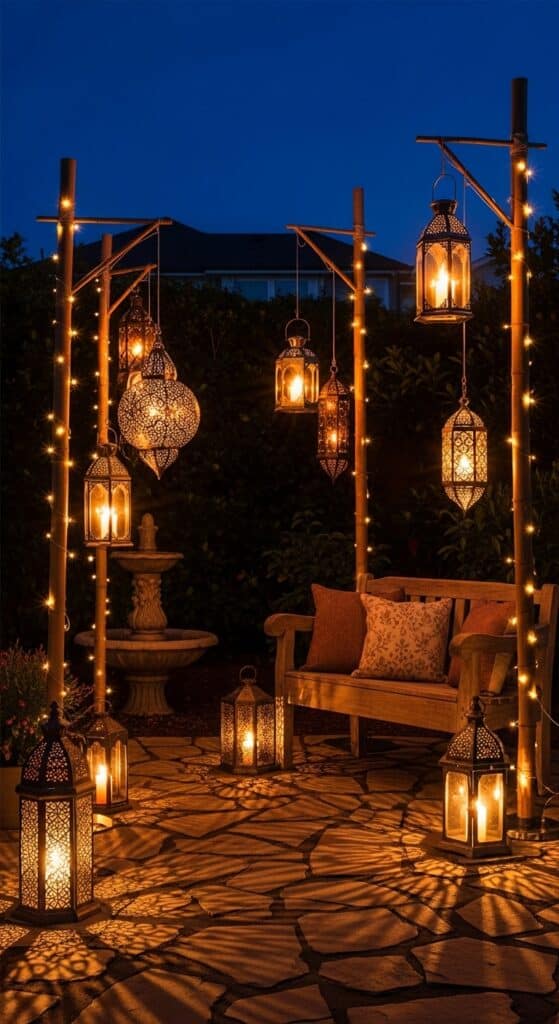
For homeowners who enjoy hands-on projects, DIY lantern poles have emerged as a creative way to add height and visual interest to outdoor lighting schemes. The concept is simple but the impact is substantial—vertical poles strategically placed around your patio or deck to suspend lanterns at various heights.
The beauty of this approach is its versatility and affordability. Basic materials like pressure-treated lumber, galvanized pipes, or even bamboo poles can be transformed into stunning lighting features with some simple hardware and a bit of creativity. Many homeowners are painting these poles in complementary colors or wrapping them with outdoor-rated ribbons or garlands to enhance their decorative appeal.
What makes the 2025 version of this trend special is the new generation of lightweight, weather-resistant lanterns designed specifically for these installations. These fixtures combine the charm of traditional lanterns with modern LED technology and materials engineered to withstand the elements. The effect creates a intimate atmosphere thats reminiscent of exotic resorts or upscale restaurants, bringing a touch of vacation-inspired luxury to your everyday outdoor space.
6. Solar-Powered Path Lights with Smart Features

Path lighting has undergone a revolution in 2025, with solar technology advancing dramatically. The days of dim, quickly-fading solar lights are firmly behind us. Today’s models store enough energy to provide bright, consistent illumination throughout even the longest summer nights, with many featuring reserve power that can maintain performance through several cloudy days.
Motion-sensing capabilities have become standard, allowing your path lights to brighten as you approach and dim when the area is vacant. This not only conserves energy but also creates a magical effect as the lights seem to acknowledge your presence. Some advanced models can even distinguish between human movement and wildlife, preventing unnecessary activation when neighborhood animals wander through.
The newest path lights communicate with each other through mesh networking, creating synchronized lighting effects that can guide visitors through your outdoor space or highlight specific landscape features as people approach them. These lights learn from usage patterns over time, automatically adjusting their behavior to complement your lifestyle—brightening earlier on evenings when you typically entertain and conserving energy when you’re typically indoors or away.
7. Immersive Lighting Environments
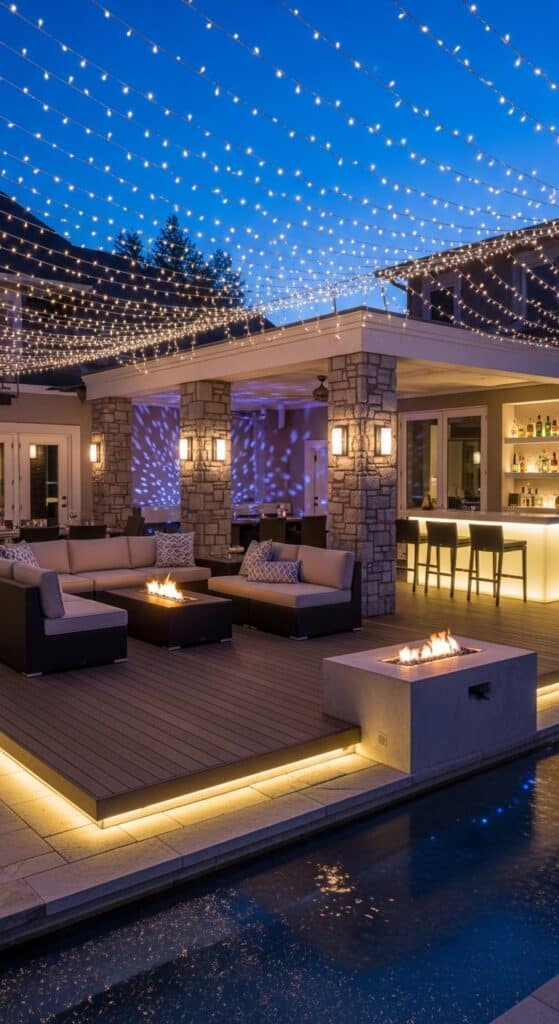
Perhaps the most exciting development in outdoor lighting for 2025 is the concept of immersive lighting environments. Rather than thinking about individual fixtures, designers are now approaching outdoor spaces as complete lighting ecosystems where different elements work together to create cohesive experiences that change throughout the evening.
These systems typically include ground-level lighting, overhead elements, and mid-height features that can be programmed to create different “scenes” for various activities or moods. A dinner party might trigger a warm, intimate setting with focused illumination on eating areas, while a larger gathering could activate a more energetic scheme with brighter, more dynamic lighting patterns across the entire space.
The control interfaces for these systems have become remarkably intuitive, often learning your preferences over time and suggesting appropriate lighting schemes based on weather conditions, time of day, or the number of people detected in the space. Some systems even respond to music, subtly pulsing or changing color to complement whatever youre listening to without creating an overwhelming “disco” effect.
8. Sustainable Materials and Manufacturing
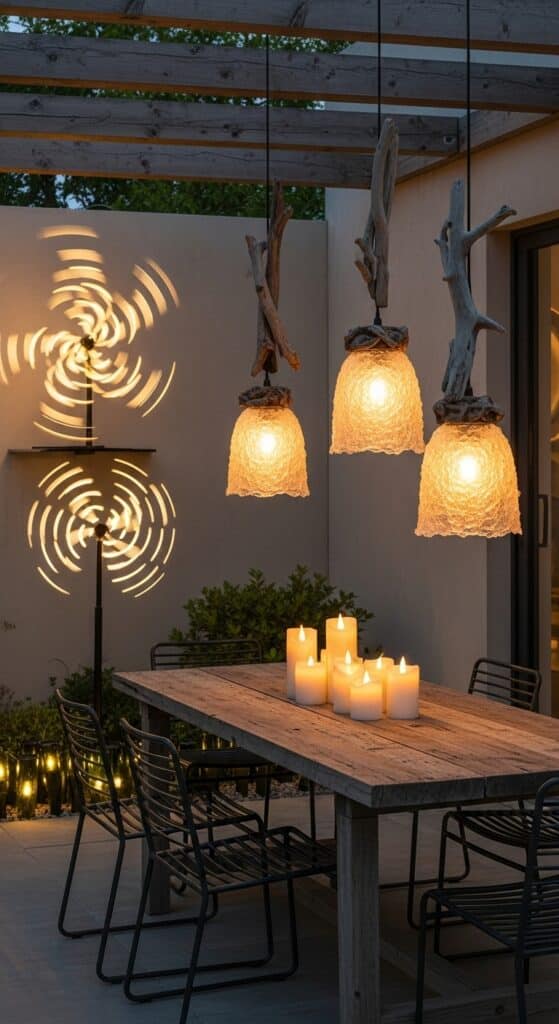
Eco-consciousness has finally reached outdoor lighting in a meaningful way. The 2025 market features fixtures made from recycled ocean plastics, reclaimed metals, and even biodegradable materials for temporary or seasonal installations. These options allow style-conscious homeowners to illuminate their spaces without compromising their environmental values.
Manufacturing processes have also evolved, with many premium lighting brands now offering carbon-neutral production and ethical labor practices. These companies provide detailed information about their supply chains and environmental impact, allowing consumers to make informed choices about the products they bring into their homes.
Battery technology has advanced significantly, with new storage systems that can power outdoor lighting through renewable energy sources even in regions with limited sunlight. Some innovative companies now offer subscription services where depleted batteries are collected for proper recycling and replaced with freshly charged units, eliminating the waste associated with disposable batteries while maintaining the convenience of cordless installation.
9. Flameless Fire Features
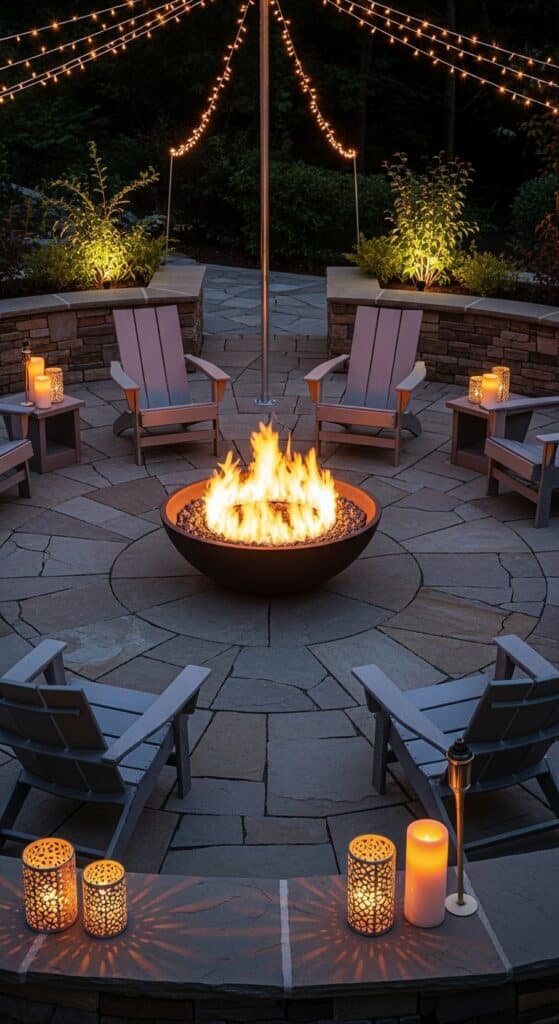
Traditional fire pits and torches have been reimagined for 2025 with flameless alternatives that provide the warm, flickering effect of fire without the associated risks or environmental impact. These fixtures use advanced LED technology and subtle air movement to create remarkably realistic “flames” that can be enjoyed year-round with zero emissions or fire hazards.
Some models incorporate scent elements that release subtle fragrances reminiscent of woodsmoke or essential oils, enhancing the sensory experience. The visual effect is so convincing that many guests dont realize they’re not seeing actual flames until they notice the absence of heat or get close enough to observe the technology in action.
For those who still enjoy the warmth of traditional fire features, hybrid systems offer the best of both worlds. These units can operate as decorative flameless fixtures most of the time but convert to actual gas flames when heat is desired. The versatility makes them practical for regions with seasonal fire restrictions or for households with varying comfort levels around open flames.
10. Architectural Integration
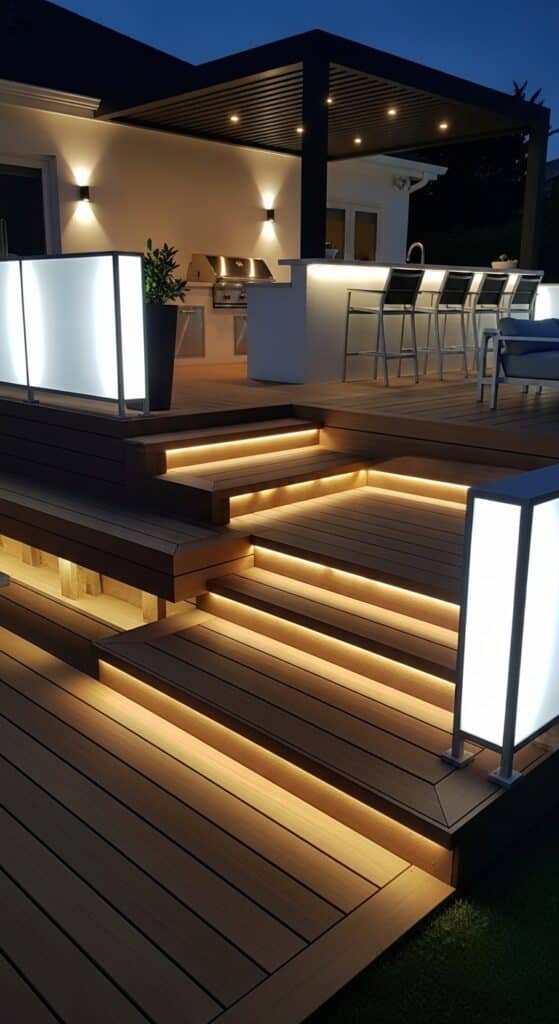
Rather than treating lighting as an afterthought, the 2025 approach incorporates illumination directly into architectural elements. Built-in lighting channels along deck edges, stair risers with integrated LEDs, and pergola beams with hidden light strips create clean, sophisticated effects without visible fixtures disrupting your design aesthetic.
The technology behind these integrations has advanced significantly, with ultra-thin LED panels that can be retrofitted into existing structures without major reconstruction. Installation systems have been simplified to the point where many homeowners with basic DIY skills can handle the projects themselves, though professional results still require careful planning and execution.
What impresses me most about this trend is how it transforms utilitarian elements into design features. A simple set of steps becomes a cascading light display, while deck railings transform into subtle light ribbons that define the boundaries of your space without creating harsh visual barriers or obstructing views.
11. Sculptural Light Installations
For homeowners looking to make a dramatic statement, sculptural light installations have become the ultimate expression of outdoor style in 2025. These artistic pieces serve as focal points that define the character of your outdoor space while providing functional illumination.
Light sculptures range from abstract forms that play with shadow and light to representative pieces that reflect the homeowners interests or the natural environment. Many feature kinetic elements that move gently with the breeze, creating ever-changing patterns that keep the visual experience fresh and engaging over time.
Commissioning custom pieces from local artists has become increasingly popular, resulting in truly one-of-a-kind installations that tell personal stories or reflect regional aesthetics. These investments not only enhance your outdoor space but often appreciate in value over time as the artists’ reputations grow—making them both beautiful additions to your lifestyle and smart financial decisions.
12. Interactive Lighting Systems
Playfulness has entered outdoor lighting design in a big way for 2025. Interactive systems respond to touch, movement, or voice commands, allowing both adults and children to engage with their environment in new ways. Imagine stepping stones that illuminate as you walk across them or garden features that change color when touched.
These systems have particular appeal for families with children, creating magical outdoor experiences that encourage physical activity and imaginative play. Many parents report that these interactive elements have successfully lured their kids away from screens and into the fresh air, especially during evening hours when outdoor play was previously limited by visibility.
The technology behind these interactions has become remarkably sophisticated yet virtually invisible. Sensors are now so small and energy-efficient that they can be embedded in almost any outdoor element without detracting from its appearance or requiring frequent battery replacement. The effect is a space that seems to respond intuitively to human presence, creating moments of surprise and delight for residents and visitors alike.
13. Weather-Responsive Automation
Smart lighting has taken a major leap forward with systems that automatically respond to weather conditions. Fixtures can now increase brightness when fog or rain reduces visibility, shift to warmer tones when temperatures drop, or activate specific lighting patterns when high winds are detected to emphasize secure pathways and deemphasize areas that might experience falling branches or debris.
These systems typically connect to local weather services to anticipate conditions before they arrive, preparing your outdoor space for incoming weather fronts. Some can even send notifications to your phone with lighting recommendations based on forecasted conditions—suggesting, for example, that you activate your covered patio lights for an upcoming evening shower.
The practical benefits of this automation are substantial, especially for homeowners who frequently entertain outdoors. Rather than rushing to adjust lighting when weather changes, these systems handle the transitions seamlessly, maintaining appropriate illumination regardless of environmental conditions. It’s like having an attentive staff member constantly monitoring and adjusting your outdoor ambiance.
14. Vintage Revival with Modern Technology
Nostalgia continues to influence outdoor design, with many homeowners seeking lighting that references historical styles while incorporating contemporary technology. Edison-style bulbs have been reinvented with LED filaments that provide the warm glow and visible elements of traditional incandescent bulbs while consuming a fraction of the energy and lasting for decades rather than months.
Victorian-inspired lanterns and mid-century modern fixtures have been reimagined with weather-resistant materials and smart capabilities, allowing homeowners to enjoy classic aesthetics without sacrificing modern convenience or durability. These pieces often become conversation starters, their familiar forms providing comfort while their unexpected features delight guests.
What makes this trend particularly appealing is its adaptability to diverse architectural styles. Whether your home is a craftsman bungalow, a sleek contemporary structure, or something in between, there are historically-inspired lighting options that can complement your architecture while providing state-of-the-art performance. The juxtaposition of old and new creates visual interest and depth that purely contemporary fixtures sometimes lack.
15. Projection Mapping for Special Occasions
While permanent lighting installations form the foundation of your outdoor illumination strategy, temporary projection systems have gained popularity for special events and seasonal celebrations. These portable units can transform any surface of your home or garden into a canvas for light displays, from subtle texture patterns to elaborate animated scenes.
The technology has become remarkably accessible, with consumer-grade projectors now offering impressive brightness, resolution, and durability at price points that make them reasonable investments for frequent entertainers. Pre-programmed content libraries provide professional-quality effects without requiring design expertise, while more ambitious users can create custom projections that reflect personal milestones or interests.
These systems are particularly valuable for seasonal decorating, allowing homeowners to transform their outdoor spaces for holidays without storing and installing physical decorations. A simple garden wall can become a spring flower display in April, a patriotic tableau in July, and a spooky scene in October—all through changing projections rather than hanging and removing decorative elements. The versatility is unmatched by any other decorating approach.
16. Color Therapy Lighting
The psychological impact of light has received increased attention in 2025, with many homeowners incorporating color therapy principles into their outdoor lighting designs. These systems use specific hues known to influence mood—blue tones for relaxation, energizing ambers for social spaces, and purifying greens for meditation areas.
Programmable zones allow different areas of your outdoor space to support various activities simultaneously. A cooking area might feature stimulating white light for food preparation, while an adjacent dining space offers warm, appetite-enhancing ambers, and a conversation area provides calming blues to encourage meaningful connections and stress reduction.
What I find most fascinating about this trend is how it transforms lighting from a purely functional or decorative element into a tool for wellbeing. Homeowners report tangible benefits from these thoughtfully designed color schemes, including improved sleep after spending evenings under appropriate lighting and more productive outdoor work sessions in spaces illuminated with focus-enhancing hues.
17. Ultra-Miniaturization
The “barely-there” lighting trend has gained significant momentum in 2025, with fixtures becoming so small they practically disappear into the landscape during daylight hours. These micro-lights can be embedded in garden beds, mounted between deck boards, or attached to the undersides of furniture without creating visual clutter or detracting from your carefully designed outdoor aesthetic.
Despite their diminutive size, these fixtures produce impressive illumination thanks to advances in LED efficiency. Their strategic placement creates layers of light that define spaces and highlight features without visible hardware competing for attention. The effect is particularly striking in minimalist outdoor designs where clean lines and uncluttered surfaces are essential to the overall aesthetic.
Installation has been simplified through standardized connection systems and weatherproof mini-hubs that can control dozens of fixtures through a single power source. This approach reduces the complexity and cost of running electrical lines to multiple locations, making comprehensive lighting schemes accessible to more homeowners regardless of their existing outdoor infrastructure.
18. Dynamic Shadow Play
While most lighting discussions focus on illumination, innovative designers in 2025 are paying equal attention to the shadows created by their fixtures. Carefully positioned lights can cast intriguing patterns that add depth and visual interest to otherwise plain surfaces, essentially creating art through absence rather than presence of light.
Adjustable fixtures allow these shadow patterns to change throughout the evening or season, with precise control over direction and diffusion. Some systems even include subtle motion elements that create gently shifting shadows reminiscent of natural phenomena like dappled sunlight through leaves or water reflections—bringing dynamic natural effects into strictly architectural spaces.
This approach is particularly valuable for extending the apparent size of smaller outdoor areas. By drawing the eye upward to wall and ceiling shadows, these lighting designs create visual complexity that makes compact spaces feel more generous and interesting. I’ve implemented this technique in urban balconies and tiny courtyards with remarkable results, transforming these limited areas into immersive environments that feel significantly larger than their actual dimensions.
19. Audio-Integrated Lighting
The convergence of sensory experiences has led to fascinating lighting systems that respond to or incorporate audio elements. Weather-resistant speakers disguised as landscape lights provide high-quality sound without disrupting your garden aesthetic, while reactive fixtures subtly pulse or change in response to music playing in your outdoor space.
Some systems include nature soundscapes that complement their lighting effects—gentle waves synchronized with blue pulsing lights for a coastal atmosphere, or cricket sounds paired with warm flickering for a campfire feel. These multi-sensory environments create remarkably immersive experiences that transport you and your guests to different settings without leaving your patio.
What surprises many homeowners is how these integrated systems actually reduce visual tech clutter. Rather than having separate fixtures for lighting and audio, these combined units serve multiple purposes while maintaining a clean, cohesive appearance. The result is enhanced functionality with minimized hardware—a win-win for both technology enthusiasts and design purists.
20. Lighting Control Revolution
Perhaps the most significant advancement in outdoor lighting for 2025 isn’t about the fixtures themselves but how we control them. Voice commands have become more nuanced, allowing you to describe the atmosphere you want rather than specifying technical parameters. Saying “make the patio feel cozy for dinner” triggers a pre-configured scene that adjusts multiple elements to create the perfect ambiance without requiring you to remember specific settings.
Gesture controls allow you to adjust lighting without any devices or voice commands—simply wave your hand to brighten pathways as you walk or make a dimming motion above a table to create a more intimate setting for conversation. These intuitive interactions feel magical rather than technical, allowing you to shape your environment as naturally as you might adjust your posture or position for comfort.
The backend systems supporting these controls have become remarkably intelligent, learning your preferences over time and suggesting optimizations based on your usage patterns. Many can even anticipate your needs based on factors like who is present in the space, recent activities, or upcoming calendar events synced from your personal devices. It’s like having a lighting designer continuously refining your space to support your lifestyle and enhance your enjoyment of outdoor living.
As we embrace these innovative lighting approaches in 2025, our outdoor spaces have transformed from simple extensions of our homes into rich, responsive environments that enhance our lives in meaningful ways. Whether your priority is creating a shows topping entertainment venue or a serene retreat for personal rejuvenation, the lighting technologies available today offer unprecedented opportunities to shape your experience of outdoor living after dark.

Mariana is the founder and voice behind Home Nookery, a curated blog dedicated to home design, décor inspiration, and cozy living. With a passion for creating beautiful, functional spaces, Mariana shares practical tips, styling ideas, and thoughtful insights to help readers turn their houses into homes. Whether you’re redesigning a room or just adding a touch of charm, she’s here to guide you with creativity and heart.
